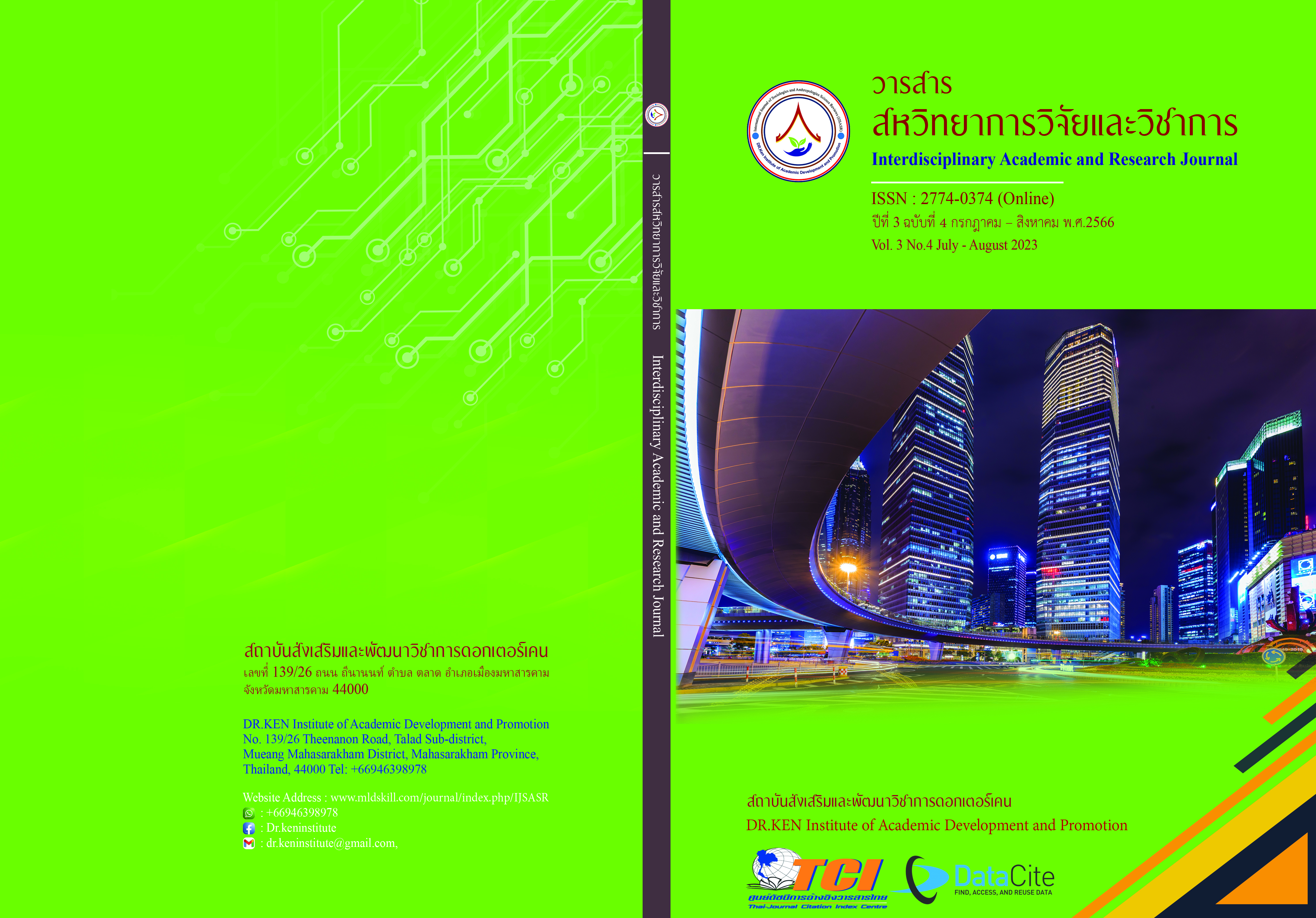Ethical behavior of students Mahamakut Buddhist University Isan Campus
DOI:
https://doi.org/10.14456/iarj.2023.207Keywords:
The Ethical Behavior; , StudentsAbstract
At present, Thai higher education still focuses on the development of morality. Student ethics are very important to the development of Mahamakut Buddhist University because students play an important role in teaching and management as well as administration. Thus, the objectives of this research were 1) to study the ethical behavior of students. Mahamakut Buddhist University Isan Campus 2) to examine and compare the ethical behavior of students at Mahamakut Buddhist University Isan Campus Classified by Individual Factors. The population used in this study was Mahamakut Buddhist University Isan Campus. Northeastern campus studying for an undergraduate degree in the academic year 2022, 960 people, using simple random sampling, is a random sample from the population, which assumes that each unit or each member in the population has an equal chance of being selected, which the sample consisted of 282 people. The statistical data used in the data analysis were frequency, percentage, mean, and standard deviation. The results show that; (1) The majority of responders were 169 females (59.9 percent) and 113 men (40.1 percent). The majority of them (63.5 percent) studied at the Faculty of Education, and the majority of them (168 individuals) obtained a GPA better than 3.00. accounted for 59.6%. (2) Mahamakut Buddhist University Isan Campus students' ethical behavior Overall, the average was very high. When each side was examined separately, it was noticed that compassion had the highest mean, followed by honesty, and discipline had the lowest. When each argument was considered, it was discovered that you are liable for public property. had the best overall average in terms of honesty, it was determined that he was truthful, understood how to respect people, and did not violate their rights. had the best overall average Regarding discipline, it came to light that he followed the competition's regulations. had the best overall average in terms of compassion, he discovered that he was able to assist others. had the most favorable overall average It has been identified that sacrifice. And (3) The results are a comparison of personal parameters of Mahamakut Buddhist University Isan Campus students in the Northeastern Campus with ethical conduct. and various faculties have distinguished ethical standards. There was statistical significance at the. 05 level. There was no variation in ethical behavior comparing students with ranging grade point averages. This contradicts the specified research hypothesis.
References
กรรณิการ์ ภิรมย์รัตน์. (2550). จริยธรรมของนักศึกษามหาวิทยาลัยราชภัฏสวนสุนันทาในศตวรรษที่ 21. รายงานการวิจัย. ทุนอุดหนุนจากมหาวิทยาลัยราชภัฏสวนสุนันทา.
กิติพันธ์ รุจิรกุล. (2552). พฤติกรรมผู้นําทางการศึกษา. กรุงเทพฯ : สํานักพิมพ์โอเดียนสโตร์.
โกวิท วรพิพัฒน์. (2554). การปฏิบัติงานของคณะกรรมการสถานศึกษาขั้นพื้นฐาน. กรุงเทพมหานคร. พีระพัฒนาการพิมพ์.
คณะกรรมการการศึกษาแห่งชาติ. สำนักงาน. (2550). การวัดและประเมินผู้เรียนด้านคุณธรรมจริยธรรม. กรุงเทพมหานคร : โรงพิมพ์การศาสนา. กรมการศาสนา
จักรี ศรีจารุเมธีญาณ. (2561). คุณธรรมจริยธรรมของนักศึกษามหาวิทยาลัยมหามกุฏราชวิทยาลัย วิทยาเขตอีสาน. รายงานการวิจัย. ทุนสนับสนุนจากโครงการวิจัยพัฒนาการเรียนการสอน. มหาวิทยาลัยมหามกุฏราชวิทยาลัย.
จุมพิต ศรีวัฒนพงศ์. (2562). ความพึงพอใจของผู้ใช้บัณฑิตที่มีต่อการทำงานของบัณฑิต หลักสูตรภาษาไทย คณะครุศาสตร์ มหาวิทยาลัยราชภัฏเชียงใหม่. รายงานการวิจัย. มหาวิทยาลัยราชภัฏเชียงใหม่.
เฉลิมพล ตันสกุล, (2541). พฤติกรรมศาสตร์สาธารณสุข. กรุงเทพฯ : ภาควิชาสุขศึกษาและพฤติกรรมศาสตร์ คณะสาธารณสุขศาสตร์ มหาวิทยาลัยมหิดล.
ณัฐพงศ์ชัย ไทรพงษ์พันธุ์. (2550). การสังเคราะห์รูปแบบการเรียนการสอนเพื่อเสริมสร้างจริยธรรมสำหรับนักศึกษาในระดับอุดมศึกษาด้วยการวิเคราะห์อภิมาน. ม.ป.ท.
บุญมี แท่นแก้ว. (2550). จริยศาสตร์ (ETHICS). พิมพ์ครั้งที่ 4. กรุงเทพฯ: โอ.เอส.พริ้นติ้ง เฮ้าส์.
ประภาศรี สีหอำไพ. (2540). พื้นฐานการศึกษาทางศาสนาและจริยธรรม. พิมพ์ครั้งที่ 3. กรุงเทพฯ: จุฬาลงกรณ์มหาวิทยาลัย.
ปัญญา เมฆบุตร. (2534). จริยธรรมกับสิ่งแวดล้อม. วารสารการวิจัยเพื่อการพัฒนา กรมการฝึกหัดครู, กระทรวงศึกษาธิการ. 15, 2534: 117-118
พระเมธีธรรมาภรณ์ (2533). ระเบียบการปกครองคณะสงฆ์ไทย. กรุงเทพฯ: มหาจุฬาลงกรณราชวิทยาลัย
พระมหาขวัญยืน สุทนฺโต (ฟางทสวัสดิ์). (2560). รูปแบบการพัฒนาภาวะผู้นำเชิงกลยุทธ์ตามแนวพุทธวิธีสำหรับผู้บริหารสถานศึกษาขั้นพื้นฐาน. วารสารมนุษยศาสตร์และสังคมศาสตร์ มหาวิทยาลัยราชภัฏอุบลราชธานี. 8 (2), 314-329.
พุทธทาสภิกขุ. (2505). แนะแนวจริยธรรม. กรุงเทพฯ : ชุมชนส่งเสริมจริยศึกษา.
พุทธทาสภิกขุ. (2553). พุทธทาสแนะแนวจริยธรรมร่วมสมัย ชุดที่ 3 จุดหมายปลายทางและตัวแท้ของจริยธรรม. กรุงเทพฯ: สำนักพิมพ์ดวงตะวัน.
แพรภัทรา เขียวชอุ่ม. (2548). ความสัมพันธ์ระหว่างพฤติกรรมทางจริยธรรมกับภาวะผู้นำการเปลี่ยนแปลงของนักศึกษามหาวิทยาลัยสยาม. ศูนย์พัฒนาการเรียนการสอน มหาวิทยาลัยสยาม.
โยธิน ศันสนยุทธ และคณะ. (2533). จิตวิทยา. กรุงเทพฯ: ศูนย์ส่งเสริมวิชาการ.
ราชบัณฑิตยสถาน. (2546). พจนานุกรมฉบับราชบัณฑิตยสถาน พ.ศ. 2542. กรุงเทพฯ: นานมีบุ๊ค พับลิเคชั่นส์.
สุมน อมรวิวัฒน์. (2526). กรณีศึกษาเพื่อการเรียนการ สอนส่งเสริมคุณธรรมจรรยาแห่งวิชาชีพครู. กรุงเทพมหานคร : จุฬาลงกรณ์มหาวิทยาลัย.
เสฐียรพงษ์ วรรณปก. (2540). พุทธวิธีสอนจากพระไตรปิฏก. นนทบุรี: บริษัท เพชรรุ่งการพิมพ์ จำกัด.
อรพินทร์ สันติชัยอนันต์. (2549). การศึกษาคุณธรรมและจริยธรรมของนิสิตนักศึกษา สถาบันอุดมศึกษาในเขตกรุงเทพมหานครและปริมณฑล. ปริญญานิพนธ์ กศ.ม. (การอุดมศึกษา). กรุงเทพฯ: บัณฑิตวิทยาลัย มหาวิทยาลัยศรีนครินทรวิโรฒ.
Best, J.W., (1963). Research in Education. New Jersey: Prentice–Hall.
Eysenck, J.J., Arnold, W, & Meili, R. (1972). Encyclopedia of Psychology. London: Search Press Limited.
Goldenson, R.M. (1984). Longman Dictionary of Psychology and Psychiatry. New York: Longman.
Good, C.V. (1973). Dictionary of Education. New York: McGraw Hill
Yamane, T., (1973). Statistics: an introductory analysis. New York: New York: Harper & Row.
Downloads
Published
How to Cite
Issue
Section
License
Copyright (c) 2023 Chakkree Sricharumedhiyan, Phrakhrusutheejariyawat, Akchatree Suksen, Phramaha Chaichana Boonnadee, Supawat Ketkatuk

This work is licensed under a Creative Commons Attribution-NonCommercial-NoDerivatives 4.0 International License.
Copyright on any article in the Interdisciplinary Academic and Research Journal is retained by the author(s) under the under the Creative Commons Attribution-NonCommercial-NoDerivatives 4.0 International License. Permission to use text, content, images, etc. of publication. Any user to read, download, copy, distribute, print, search, or link to the full texts of articles, crawl them for indexing, pass them as data to software, or use them for any other lawful purpose. But do not use it for commercial use or with the intent to benefit any business.
















.png)


